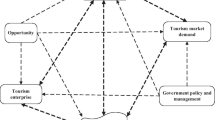Abstract
Under the background of large data, demand forecasting of rural tourism based on intelligent algorithm is a new direction to promote the development of rural tourism industry. This paper mainly studies the application of neural network intelligent algorithm in rural tourism. Firstly, from the perspective of inbound tourism demand, the influencing factors of inbound tourism demand are clarified. Considering the influence degree and quantification difficulty of each factor, seven influencing factors are extracted to construct the inbound tourism feature vector. Then taking Yangjiang inbound tourism as an example, we use the neural network model to forecast the number of inbound tourists in Yangjiang from 2018 to 2019. The mean square error of the network is 0.011695 and the coefficient R2 is 0.94744; the results of the model are acceptable. Finally, from the perspectives of changing marketing strategy and pricing strategy, this paper puts forward some suggestions for the improvement of rural tourism.








Similar content being viewed by others
References
Yang X, Pan B, Evans JA, Lv B (2015) Forecasting Chinese tourist volume with search engine data. Tourism Management 46:386–397
Pan B, Chenguang Wu D, Song H (2012) Forecasting hotel room demand using search engine data. Journal of Hospitality and Tourism Technology 3(3):196–210
Gu W, Ren M (2015) Mining and analysis of rural tourism data in era of big data. Acta Agriculturae Jiangxi 27(8):143–150
Liu YY, Tseng FM, Tseng YH (2018) Big Data analytics for forecasting tourism destination arrivals with the applied vector autoregression model. Technological Forecasting and Social Change 130:123–134
Huang Y, Zhou Z, Huang J (2014) Temporal and spatial variations of rural tourism development in age of big data. Acta Agriculturae Zhejiangensis 26(6):1709–1714
Hirashima A, Jones J, Bonham CS, Fuleky P (2017) Forecasting in a mixed up world: now casting Hawaii tourism. Annals of Tourism Research 63:191–202
Zhang GP, Kline DM (2007) Quarterly time-series forecasting with neural networks. IEEE transactions on neural networks 18(6):1800–1814
Hamzaçebi C (2008) Improving artificial neural networks’ performance in seasonal time series forecasting. Information Sciences 178(23):4550–4559
Hassani H, Silva E (2015) A Kolmogorov-Smirnov based test for comparing the predictive accuracy of two sets of forecasts. Econometrics 3(3):590–609
Claveria O, Monte E, Torra S (2015) Tourism demand forecasting with neural network models: different ways of treating information. International Journal of Tourism Research 17(5):492–500
Law R (2000) Back-propagation learning in improving the accuracy of neural network-based tourism demand forecasting. Tourism Management 21(4):331–340
Law R, Au N (1999) A neural network model to forecast Japanese demand for travel to Hong Kong. Tourism Management 20(1):89–97
Claveria O, Torra S (2014) Forecasting tourism demand to Catalonia: Neural networks vs. time series models. Economic Modelling 36:220–228
Olmedo E (2016) Comparison of near neighbour and neural network in travel forecasting. Journal of Forecasting 35(3):217–223
Silva ES, Hassani H, Heravi S, Huang X (2019) Forecasting tourism demand with denoised neural networks. Annals of Tourism Research 74:134–154
Hassani H, Silva ES, Ghodsi Z (2017) Optimizing bicoid signal extraction. Mathematical biosciences 294:46–56
Hassani H, Silva ES, Antonakakis N, Filis G, Gupta R (2017) Forecasting accuracy evaluation of tourist arrivals. Annals of Tourism Research 63:112–127
Dwyer, L., Forsyth, P., & Dwyer, W. (2010). Tourism economics and policy (Vol. 3). Channel View Publications.
MuqoZ TG (2007) German demand for tourism in Spain Teresa GarCnMuQoza. Tourism Management 28(1):12–22
Coshall JT, Charlesworth R (2011) A management orientated approach to combination forecasting of tourism demand. Tourism Management 32(4):759–769
Formica S, Uysal M (2006) Destination attractiveness based on supply and demand evaluations: an analytical framework. Journal of Travel Research 44(4):418–430
Nicoletta R, Servidio R (2012) Tourists’ opinions and their selection of tourism destination images: an affective and motivational evaluation. Tourism Management Perspectives 4:19–27
Witt SF, Witt CA (1995) Forecasting tourism demand: a review of empirical research. International Journal of forecasting 11(3):447–475
Kon SC, Turner LW (2005) Neural network forecasting of tourism demand. Tourism Economics 11(3):301–328
Song H, Wong KK, Chon KK (2003) Modelling and forecasting the demand for Hong Kong tourism. International Journal of Hospitality Management 22(4):435–451
Huang YH, Stewart WP (1996) Rural tourism development: shifting basis of community solidarity. Journal of Travel Research 34(4):26–31
Hwang D, Stewart WP, Ko DW (2012) Community behavior and sustainable rural tourism development. Journal of Travel research 51(3):328–341
Lane B, Kastenholz E (2015) Rural tourism: the evolution of practice and research approaches–towards a new generation concept? Journal of Sustainable Tourism 23(8-9):1133–1156
Grunwell, S. S. (2014). How to revitalize a small rural town? An empirical study of factors for success. University-community collaboration with a small historic rural tourism town. Journal of Rural and Community Development, 9(2).
Gullino P, Larcher F (2013) Integrity in UNESCO World Heritage Sites. A comparative study for rural landscapes. Journal of Cultural Heritage 14(5):389–395
Wang Y, Pfister RE (2008) Residents’ attitudes toward tourism and perceived personal benefits in a rural community. Journal of Travel Research 47(1):84–93
Funding
This research is supported by the Fund for Shanxi “1331 Project” Key Innovative Research Team (No. 1331KIRT); project support of Guizhou Sports Bureau in 2018 (No. GZTY2018102); Program for the Philosophy and Social Sciences Research of Higher Learning Institutions of Shanxi (No. 201803051); and funding program of Shanxi Provincial Soft Science Research Project (No. 2017041022-3).
Author information
Authors and Affiliations
Corresponding author
Additional information
Publisher’s note
Springer Nature remains neutral with regard to jurisdictional claims in published maps and institutional affiliations.
Rights and permissions
About this article
Cite this article
Shi, X. Tourism culture and demand forecasting based on BP neural network mining algorithms. Pers Ubiquit Comput 24, 299–308 (2020). https://doi.org/10.1007/s00779-019-01325-x
Received:
Accepted:
Published:
Issue Date:
DOI: https://doi.org/10.1007/s00779-019-01325-x




